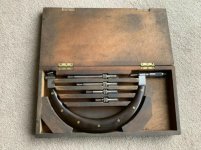With all due respect, if something has a Starrett catalog number on it, it's a production item and not something "never seen". On the other hand, Starrett did, and continues to, make special measuring instruments to customer's designs. In one old catalog, Starrett had a picture of a "truss frame" micrometer made special for a customer who needed to mike very large diameter parts. Remembering that, when we had a need to take mike readings on some of the hydro turbine parts at the powerplant I worked at, I contacted Starrett. We needed a mike which could reach aways out onto some assembled turbine parts to get the overall thickness. The result was a mike with a frame having a very deep throat as well as quite a distance between spindle and anvil. I worked with an engineer at Starrett, and we came up with a fabricated aluminum frame, sufficiently rigid and stress relieved after welding. I believe the assembled frame was then re-tempered before final machining. The mike arrived in a large plywood case, and we used it when we did major overhaul work on some of the thrust bearing parts. It's been easily 20 years since I thought of that mike.
In a Starrett catalog of the 20's or 30's which I saw as a boy in a neighbor's basement, there was a photo of a machinist miking a "wheel center" for a steam locomotive. The wheel center (the spoked wheel casting for a drive upon which a steel tire is shrink-fitted) was about as tall as the guy miking its diameter.
I believe this likely to advertise the fact Starrett could build micrometers for nearly any purpose.
Another micrometer which Starrett offered was the "boiler inspector's micrometer". In the days before ultrasonic thickness gauging, if the thickness of the wall of an existing boiler or pressure vessel had to be determined, Starrett offered a special mike for the purpose. A small hole was drilled thru the shell of the boiler or pressure vessel at the area in question (I know, someone will ping on me about making sure the boiler or pressure vessel was out of service, pressure bled off and drained down..). The mike consisted of a hooked rod like a candy-cane. The tip of the "handle" of the candy cane formed the anvil of the mike. Once the hooked rod was in place thru the hole, the rest of the mike frame then fastened to it. After taking the thickness measurement, the hole was then tapped and plugged- assuming the mike reading showed sufficient thickness for the service the boiler or pressure vessel would see.
I've seen a lot of Starrett tools over a career spanning more than 50 years, and I've done engineering on about 24 steam locomotive boiler for determined fitness for service as well as repairs and alterations. I never bothered to count how many other pressure vessels, penstocks (large steel pipes feeding water to hydro turbines), tanks and similar work I've handled. Never saw one of those boiler inspector's mictometers.
Another mike Starrett advertised as making available has its graduations in Braille. I believe Starrett produced these mikes and made them available at no cost to industries and organizations training or employing the blind.
I own a mike made by Brown & Sharpe that is one I have never seen before or since. An old neighbor, a master toolmaker of the old school, since deceased, bought it new. When he was near the end of his life, well into his 90's he had me come over to buy some of his tools. One of the items he threw into the lot was a very heavy framed mike with an oversized head, made by Brown and Sharpe. I'd have to dig it out as I've never used it myself. The oldtimer claimed he bought it for one job, and that was so long ago in his own past he forgot what he bought it for. I believe the heavy framed mike was known as "grinder micrometer".
In response to Thermite's customary somewhat caustic wit, I know there was always a controversy as to which firm made the better measuring instruments. Starrett, likely by sheer volume of tools produced and the extensive line they offered, as well as dealer network, seemed to be "the name". I grew up knowing Starrett from the time I was a kid. In high school, I came to know Brown and Sharpe. Amongst a lot of machinists and toolmakers in the 50's-90's, Brown and Sharpe was said to produce a better tool than Starrett. I've got mostly Starrett in my own chests, but plenty of Brown and Sharpe and some Mitutoyo tools. A few stray Lufkin tools also are in my chests. Unfortunately, Brown and Sharpe is no longer a major player in the measuring instrument field. In the days when they were building the tools in their Rhode Island works, they were building some very fine tools. Nowadays, when I buy dial indicators for my own shop, I go with Mitutoyo. I never had occasion to get into the kind of metrology that Thermite speaks of. For day-to-day machine shop work or erecting turbines and generators, Starrett has always made fine tools and it is what we mainly buy at the powerplant. Imagine buying a dozen 1" travel AGD style dial indicators graduated in 0.001" in one order. This is the kind of thing we did at the powerplant if we had a big repair or major overhaul coming up. We wrote a purchase requisition and it was ALWAYS for Starrett tools. After an outage or major overhaul, we'd send a bunch of dial indicators back to Starrett for repair and/or recalibration. A few indicators would get dropped or smacked as a matter of course during these kinds of jobs, and we'd send them back to Starrett. Starrett is a household name in the powerplant and in many shops to this day.


















